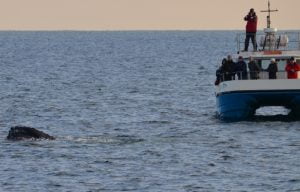Firstly, happy New Year to those of you with nothing better to do than read my skipper’s tales!
I’ve been mulling over the idea of sharing this interesting sighting I made a few years back, so here goes……
I have often been asked, whilst out on whale watch trips, what was the strangest thing I had ever seen at sea. One incident springs to mind straight away, that occurred on a whale watch on December 4th 2008, and perhaps should be listed as unlikely, rather than strange…..
It was a very good day of whale watching, in rather windy conditions, in a period of intense whale activity, with all whale species present, – minke, fin and humpbacks, and hundreds of common dolphins keeping them company. Good viewing of all species was had on this day, and around mid-day, a little over 4 miles off and directly south of Galley head, I spotted a humpback that was bubble netting under a large cloud of kittiwakes. Always a delight to witness, I moved the boat in closer to watch the action, and this was no exception. As usual, the humpback took no notice of our presence, and continued non-stop bubble netting while we watched in awe.
For those not familiar with this activity, bubble fishing is a skill unique to humpback whales. Having located a shoal of suitable prey, the whale dives down just below the shoal, and commences to blow out a thin and continuous stream of air, whilst circling around the intended prey. This action creates a circular curtain of rising air bubbles around the fish. Alarmed by the bubble curtain and the large predator below them, the fish crowd together and rise up in the water column. Now the humpback spirals inward whilst continuing the bubble stream, until the shoal is crowded in a narrow bubble ring of just a few metres diameter. With this all in place, the whale comes thundering up the bubble tube it has created, opens its mouth just below the surface, and engulfs all the fish it has trapped as it breaks the surface, affording whale watchers a view of the entire head out of the water as the mouth closes to contain the reward for its efforts.
 Back to the story……. After watching this humpback carry out four or five bubble rings, I suddenly noticed a small animal in the water paying close attention to all this action. I was just thinking to myself…… “that’s a very small seal”, when it upended to dive, and I saw it had a tail. Amidst all the excited kittiwakes, grabbing dazed and disorientated fish that had escaped from being whale food, was an otter! I looked on, in complete disbelief at this animal, following the humpback along and competing with the kittiwakes for an easy meal. I should point out this is our European river otter, a land mammal, (we don’t have “sea otters” in the Atlantic) more than four miles from the nearest land. How did an otter learn that it was worth following a feeding humpback whale miles out at sea?
Back to the story……. After watching this humpback carry out four or five bubble rings, I suddenly noticed a small animal in the water paying close attention to all this action. I was just thinking to myself…… “that’s a very small seal”, when it upended to dive, and I saw it had a tail. Amidst all the excited kittiwakes, grabbing dazed and disorientated fish that had escaped from being whale food, was an otter! I looked on, in complete disbelief at this animal, following the humpback along and competing with the kittiwakes for an easy meal. I should point out this is our European river otter, a land mammal, (we don’t have “sea otters” in the Atlantic) more than four miles from the nearest land. How did an otter learn that it was worth following a feeding humpback whale miles out at sea?
Irish otters spend a lot of their time in salt water, around the coastline and estuaries. I have seen otters at the Stags and High and Low Island before. The Stags are about a mile from the mainland; High and Low Islands a little less than that, but I wouldn’t recommend looking for otters miles offshore. Had anyone ever told me they had witnessed such as this, I would not have believed it. Fortunately, there was a boat full of witnesses on board to verify that this happened. I have never come across any other account of an otter in an offshore situation under similar circumstances. Guess it offers us some clues as to how our river otters are evolving, as they explore new ecological niches.
By Colin Barnes
Cork Whale Watch

2 comments
Conor Ryan
What an incredible sighting! It would be a good note for the Irish Naturalists’ Journal.
Happy New Year
Conor
Pádraig Whooley
Hi Conor….yes, not a bad suggestion at all. I have while whale watching off West Corks cliffs seen otters perhaps on 2 occasions 1-2km out, but never directly interacting with a whale. So it seems noteworthy alright. Padraig
Comments are closed.